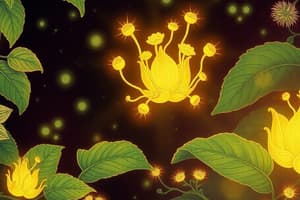Podcast
Questions and Answers
What is photosynthesis?
What is photosynthesis?
The process by which plants use light energy to convert water and carbon dioxide into oxygen and glucose.
What is a chloroplast?
What is a chloroplast?
An organelle found in plant cells where photosynthesis occurs.
What is chlorophyll?
What is chlorophyll?
The green pigment in plants' chloroplasts that absorbs light energy used to carry out photosynthesis.
What is glucose?
What is glucose?
What is the photosynthesis formula?
What is the photosynthesis formula?
Flashcards are hidden until you start studying
Study Notes
Photosynthesis Process
- Photosynthesis allows plants to convert light energy into chemical energy, producing glucose and oxygen.
- Essential reactants include water (H₂O) and carbon dioxide (CO₂).
Chloroplast
- Chloroplasts are specialized organelles present in plant cells.
- Sites of photosynthesis where light energy is transformed into chemical energy.
Chlorophyll
- Chlorophyll is the key green pigment within chloroplasts.
- It captures light energy, primarily in the blue and red wavelengths, aiding in the photosynthesis process.
Glucose
- Glucose is a simple sugar, crucial as a primary energy source for plants and other living organisms.
- It serves as a fundamental building block for energy-rich carbohydrates.
Photosynthesis Formula
- The overall chemical reaction for photosynthesis can be summarized as:
- 6CO₂ + 6H₂O + sunlight → C₆H₁₂O₆ + 6O₂
- This formula highlights the transformation of carbon dioxide and water into glucose and oxygen, facilitated by sunlight.
Studying That Suits You
Use AI to generate personalized quizzes and flashcards to suit your learning preferences.



